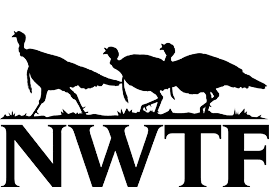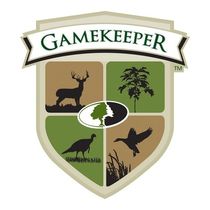Rut Creek Consulting does not own any rights to the material marked **
Will He Be a Good One Next Year?
**Article by Lindsay Thomas Jr. of QDMA (https://www.qdma.com/will-good-one-next-year/)
Every buck’s path in life is unique, and so is every buck’s antler growth progression. Ups and downs come with external factors like drought (or, conversely, abundant rain), poor mast crops (or heavy ones), severe winters (or mild ones), injuries (or the lack of), and disease (or good health). In the middle of his life a buck might drop in antler size from one year to the next in response to such factors, or he might make an unusually large leap in antler size from one year to the next. So, no one has a crystal ball, and no hunter is safe reading fortunes for any individual buck.
However, we know that taken as a group and averaged out to determine the norm, bucks grow a larger set of antlers each year of their life up to a point. The graph below, based on research at Mississippi State University and Texas A&M-Kingsville, is a striking visual depiction of this knowledge. It shows the average percentage of maximum gross Boone & Crockett score achieved by age class.
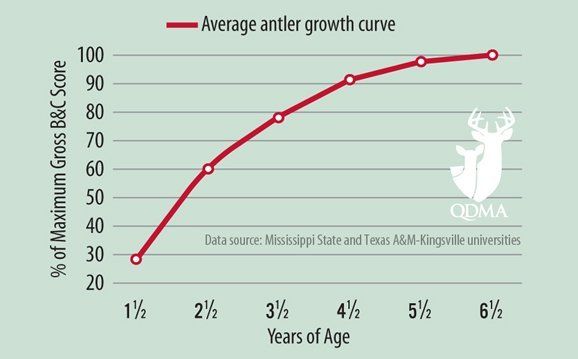
Even though some individual bucks will stray from this red line, we can extract a number of broader lessons and guidelines from the graph. Here are a few points that stand out to me.
The gains in antler growth are biggest in the early years. A buck will likely make his greatest leap in antler size, as a percentage of his lifetime potential, from 1½ to 2½ years of age – nearly doubling his antler size and expanding from only 30% of his potential to 60% of his potential. “Let him go so he can grow” is most relevant to yearlings, because they will likely make a big jump in antler size if they can only survive their first year with antlers. This is a great selling point to get non-QDM’ers to test the water and begin protecting yearlings. You’re not asking them to wait till a buck is 5½. If they can pass that forkhorn yearling and shoot him next year at 2½, they’ll be dragging out a significantly larger buck, both in body and antlers.
A middle-aged deer is a nice buck for any hunter. For many good reasons, a lot of hunters choose wisely to take bucks at 2½ or 3½ years of age. This is perfectly within the goals of QDM; anyone who says you have to wait for full maturity when practicing QDM is flat wrong. Moreover, these hunters are taking a really nice buck. At 2½ a buck is likely displaying 60% (the majority) of his lifetime antler potential. At 3½ he’s likely displaying 80%. At this point, he might have been “a good one next year” but likely not a whole lot better. A buck that scores in the 120-class at 3½ is unlikely to become a Booner, and most hunters (if they are totally honest about it) turn into wobbling jelly when they see a 120-inch buck. I know I do!
For more advanced QDM’ers, aging mistakes are critical at 3½. If you are among the uncommon hunters who enjoy an abundance of adult bucks where they hunt, you may now be trying to kill bucks at the peak of their maturity and antler size. This chart shows you the importance of recognizing and protecting high-scoring 3½-year-olds. Those rare bucks on the right side of the bell curve, the valedictorians in their age class, will really be impressive at 3½. A buck that reaches the 170s by full maturity is likely 140 at 3½ and in the 150s at 4½, a size that will severely test your commitment to your age estimate!
“Standing crop” decisions can start at 3½. Dr. Steve Demarais and Dr. Bronson Strickland of Mississippi State University wrote a great article for Quality Whitetails recently about “standing crop” management for hunters in advanced stages of QDM success. Once you’ve produced an abundance of adult bucks, it’s wasteful to kill only the top performers and pass the bucks on the left side of the bell curve just because they don’t score high. That’s a recreational opportunity and hunting achievement someone could be enjoying, not to mention the venison. If you are confident a buck is 3½ or 4½, and he’s on the low end of antler scores for that age class where you hunt, this chart helps you confidently green-light that buck and enjoy the harvest earlier than you would with others. You must first determine the average scores by age class for bucks where you hunt to be able to make these decisions correctly, and you can get this age and antler score information from bucks you’ve already killed. But, remember what Steve and Bronson said in their article: the weakest link in this process is usually the hunter’s skill at accurately judging age and antler score of live bucks!
“Huntability” is the missing line on the graph. We don’t have definitive research on this, but I think hunters and researchers alike can agree that bucks often get harder to see and kill as they get older. They may become more cautious or nocturnal, but they also might die of some other cause in the meantime. If we could chart that relationship and combine it with the graph featured here, it would likely show us a distinct trade-off. If you choose to let a buck reach 100% of his antler potential at age 5½ or 6½, you are accepting a greatly increased risk of not being able to see or kill the buck at all. At 1½, bucks are curious, inexperienced, and visible. At 5½, not so much. I believe this should factor into your decision to take or pass a buck using this graph as your guide. While that 3½-year-old in your sights might be “a good one next year,” he may not appear in your sights next year. Understand that passing such a buck doesn’t guarantee he will be available for harvest in the future.
There’s one more factor you can’t and never will see on this chart: Fun. No two hunters approach buck-harvest decisions from the same perspective or experience level. When you see and study a buck in the field, you won’t have to look at this chart or any other numbers or science to know whether he’s one you want to take home with you. If he makes you a happy hunter, who cares what he’d have been next year? He’s a great buck right now.
5 Tips For Getting and Keeping Youth Interested in Deer Hunting
**Article by: Brian Grossman at QDMA (https://www.qdma.com/5-tips-getting-keeping-youth-interested-deer-hunting/)
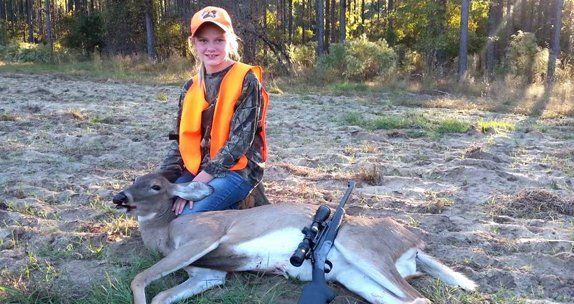
Next fall will mark 30 years of deer hunting for me. You can’t spend that much time in the woods without accumulating a lot of special memories. I still vividly remember the details of my first successful deer hunt, my first turkey, and my first good buck with a bow. But none of those accomplishments mean near as much to me as watching my 8-year-old son squeeze the trigger on his very first deer or my 9-year-old daughter harvesting her first buck.
This past season, I never even got to draw my bow back on a good buck, but my now 15-year-old son was able to harvest one his first time hunting “away” from me. Hearing his shot and getting the text that he had just killed a buck was more exciting than if I had pulled the trigger myself.
Like most fathers who love to hunt, my hope has always been to share my passion for deer hunting and enjoying the great outdoors with my children. That dream became clearly evident to my wife when I brought our son home from the hospital in little Mossy Oak bib overalls. I know too many hunters, however, whose kids have grown up with little or no interest in following in their parents’ footsteps when it comes to pursuing shooting sports, and I have often wondered what separates those kids who develop the passion from those who don’t. While there’s no guaranteed formula for getting and keeping our kids involved in hunting, there are certainly things we can do as a parent or mentor to increase the odds of them developing that lifelong passion. Let’s take a look at five of those things.
GET THEM INVOLVED AT AN EARLY AGE
From my experience, and the experience of others whom I have talked with, kids generally take a very early interest in their parents’ passion for the outdoors. For me, that was when they were around 2 years old. It started with questions about where I was going and what Daddy was doing. Then, when I actually brought home some type of critter, they were out there watching me cut it up, looking it over closely, and, of course, poking and prodding on it in amazement. All of this youthful curiosity builds over time until the question is finally asked, “When can I go hunting with you?”
Initially, this was a very tough question for me, because I have a tendency to take hunting very seriously – often too seriously. I wanted to get them involved, but the selfish side of me knew that taking them would require me to change the way I hunt, to get past the usual expectations and just plan on having a good time together. I soon realized that hunting with a young child means making the trips short, being ready to answer lots of questions, lowering my hopes of actually harvesting anything, and most of all, keeping it fun for the child.
MAKE IT FUN
Regardless of the child’s age, these early days afield with you are probably the most critical in determining whether or not he/she maintains an interest in hunting. These first hunts, like any first impression, are where the child is going to form their opinion about hunting. They are either going to decide that hunting is fun and enjoyable or that it is boring. So, it is your job to make sure it’s fun!
Probably the first step to ensuring that a child’s first hunt is not their last is to keep the initial outings brief. As a parent, you’ve probably already witnessed just how short an attention span most kids have these days, and the last thing they want to do is go sit in a blind or a treestand for hours on end, not being able to move around or talk. In most cases, you’ll have a pretty good idea when it’s time to head back, as most kids won’t hesitate to let you know when they start to get bored. I would get questions like, “How long are we going to stay out here?” or “Are we going to sit in this spot the whole time?” When my son was trying to be a little more subtle about things, he would simply ask what time it was.
Regardless of how they let you know, as soon as you detect boredom, either head to the house, or change things up a bit to keep them entertained.
DON’T PUSH THEM
I can still recall the events following my son harvesting his first deer. After the initial excitement of the harvest, I could see that he was a little upset. The remorse over taking the life of a living creature had set in, and he was questioning what he had done. It was a sobering moment for the both of us. I told him that day, and have told him numerous times since, that my love for him is unconditional, and regardless of whether or not he hunts, that’s not going to change. Fortunately, he made his own decision to continue hunting and has since taken numerous deer and his first turkey. I have had the joy of watching his interest and passion grow considerably over the last several years.
Had I chosen to push him early on and make him go with me when he didn’t want to, or had I belittled him for feeling remorse over his first deer, things could have turned out quite different. I’ve watched numerous kids lose interest in hunting (and lots of other sports for that matter) because a parent pushed them so hard to keep them involved. We, as sportsmen, all want our kids to share our love for hunting and the outdoors. However, we can’t force them to share that love, and any attempt to do so is only going to risk driving them further away. If they don’t show as much interest as you would like, then give them their space. Always keep the invitation open, but never force them to be an unwilling participant.
PROVIDE THEM WITH THE RIGHT GEAR
Going hand-in-hand with keeping hunting fun for the kids is keeping it comfortable, and that means providing your kid(s) with the proper clothing and equipment. Even for a diehard hunter, there is nothing worse than sitting in a deer stand freezing your butt off while trying to stay out there as long as possible. If it is miserable for us, imagine how much more miserable it is for a kid who is accustomed to a steady 72 degrees indoors. I still remember how completely unprepared I was when my son first started going afield with me. We layered him up in a bunch of mismatched clothes, baseball socks that pulled up over his knees (all his other socks were footies!), one of my oversized hats and a pair of big snow boots. He reminded me of the kid from the movie “A Christmas Story” who was so bundled up that he fell down and couldn’t get back on his feet. I quickly realized that if I was going to continue taking my son with me, I was going to have to get him some clothes that not only fit him properly but that would also make him look the part of a hunter. Let’s face it – kids want to be like Dad or Mom (at least until they hit the teenage years).
Just as important as the clothes they wear is the gun or bow they carry. Proper fitting is crucial to both the safety and enjoyment of your child. For a gun, that means making sure your child can properly shoulder and aim the firearm and the recoil isn’t more than they can handle. For a bow, it means finding one with the proper draw length for a good anchor point and the right draw weight so the child doesn’t have to strain to pull the bow back. If a kid doesn’t feel comfortable shooting the gun or bow, then chances are, they won’t be able to shoot it accurately or consistently. This will quickly lead to frustration and disappointment. If you are truly serious about getting your child involved, make sure you equip them properly, just as you would yourself.
HELP THEM BE SUCCESSFUL EARLY ON
Finally, for a kid to remain interested in hunting, sooner or later they are going to have to taste some success. While you and I may be able to sit in a treestand for hours on end, day after day, and never draw our bow back or click the rifle off of safety, a youngster is going to quickly deem that as boring! This may mean starting them out on something like squirrels or doves where there is no shortage of shooting opportunities. Or, in my son’s case, taking him deer hunting in areas where I knew there were plenty of does to thin out. Sure, I would love to see him shoot a nice buck, but first I wanted him to experience the excitement of having an animal come in and present a shot opportunity. Once he experienced that first taste of success with both deer and turkey, he was hooked. He no longer minds spending a little time waiting because he knows that sooner or later an opportunity will present itself, and he knows the rush he gets when it does.
There is nothing more rewarding than watching your child harvest his/her first game animal. To see the excitement in their eyes and to feel the pride of knowing you played a big part in their success is a feeling like no other. Most of all, it is the bond that develops between you and your child that makes it so special. It is a closeness that could only come from time shared afield. A bond that, if properly nurtured, will last a lifetime.
Take some time to get your child (or nephew, niece, or neighbor) out in the field. I can guarantee you will be glad you did!
Do Mild Winters Mean Smaller Antlers?
**Article by: Kip Adams at QDMA (https://www.qdma.com/mild-winters-mean-smaller-antlers/)
Whitetail antler growth is driven by photoperiod and regulated by hormones. In general, antlers begin growing in spring, grow through late summer, shed velvet around early September, fall off in winter, and start growing again a couple of months later. Most bucks cast their antlers in January to February and start new ones in March to April.
Some bucks drop their antlers early as a result of poor nutrition or an injury, while some carry them longer due to a continued presence of estrus does or frequent fighting that can keep testosterone levels elevated. Good nutrition and mild conditions can also delay antler casting.
This is exactly what happened in many regions during the mild winter of 2016-17. Bucks from several areas carried their antlers into March and April of 2017 as a result of above average temperatures and, in the north, below average snow depths. What happens to the next set of antlers when the prior set was shed much later than normal? There’s very little data on this subject. You’d hope bucks that shed late as a result of good conditions wouldn’t be penalized with less antler growth.
A good friend in Saskatchewan asked me that exact question this summer as he had some interesting trail-camera photos of two bucks he had a history with. Dean Partridge is the owner of Canadian Whitetail TV on the Pursuit Channel and WILD TV. He’s a passionate conservationist and one of the most disciplined hunters I know. He also spends a tremendous amount of time monitoring the deer herd in his area, as he and a coworker, Steve, average reviewing 10,000 trail-camera photos per week from January to June and 30,000 per week from July to December. That equals nearly 1 million trail-camera photos per year! Suffice it to say, Dean has a lot of information and a lot of history with the local deer herd. Here is the story of two mature Saskatchewan bucks Dean named “Flyer” and “FF.”
The photos below show Flyer in June and late August 2016, and in June and early September 2017 for comparison.
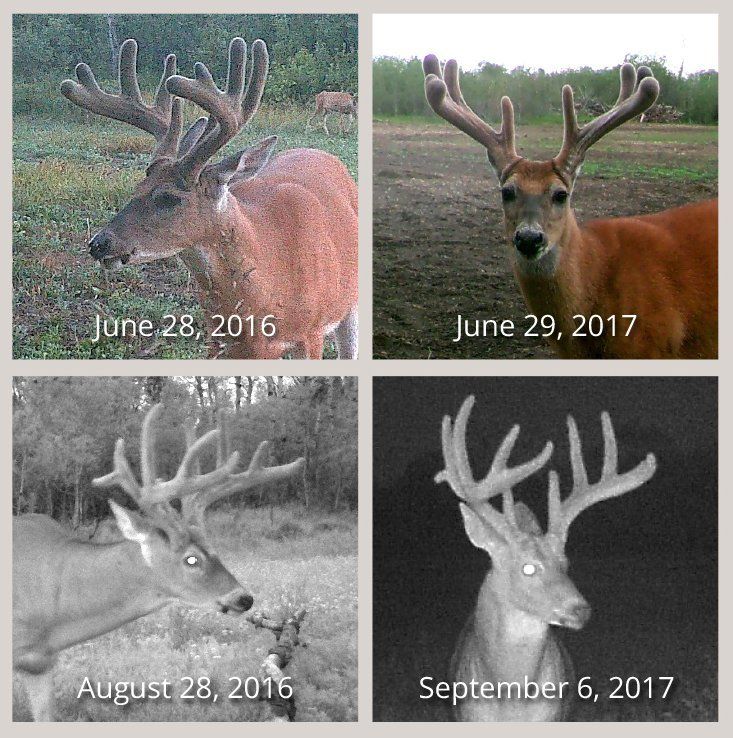
Quite a difference! Interestingly, most bucks in Dean’s area shed their velvet in late August or early September, but Flyer still had his on September 13.
Now here’s the other buck, FF, on similar dates in July, August and September 2016 and 2017. FF shed his velvet on time in 2017.
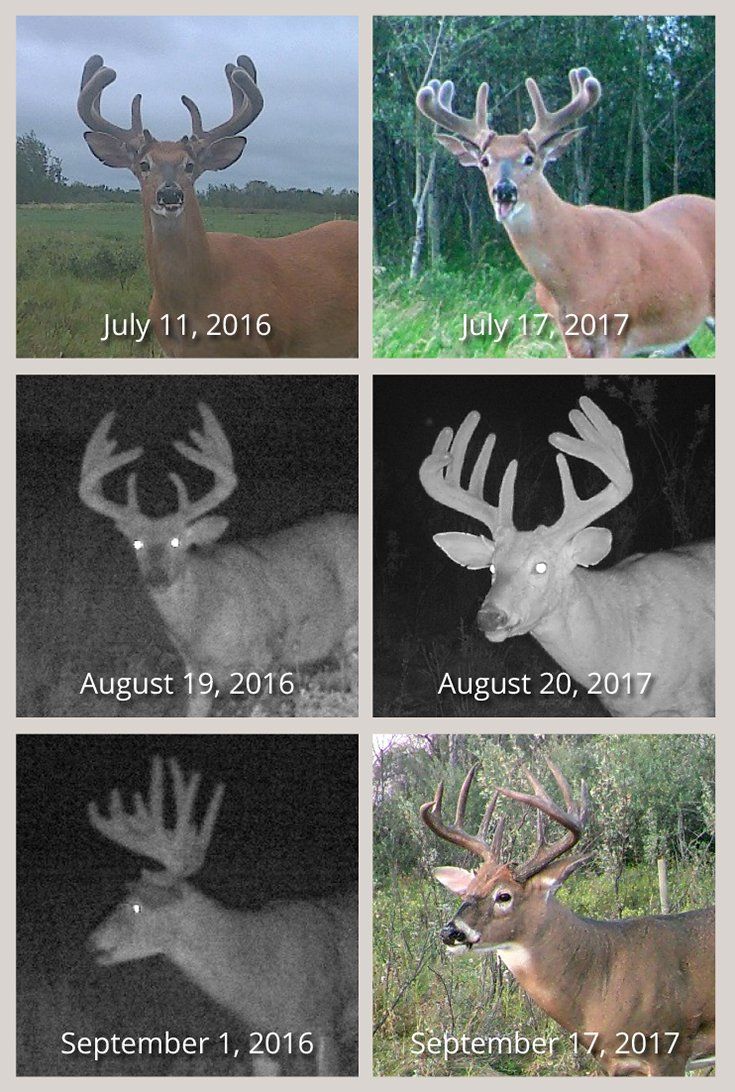
Until bucks are past their prime, another year of age typically adds several inches of antler. Dean estimated Flyer was 5.5 years old and FF was likely 7.5 years old in 2016. Thus, both bucks could/should have easily grown larger antlers in 2017. In addition, mild winters often allow bucks to put additional nutrition to antler growth the following year and have larger antlers to show for it. Unfortunately for these bucks that was not the case. Flyer lost about 15 inches of antler from 2016, and FF lost 25 to 30 inches!
How did this happen? Was it due strictly to their late antler drop, or something else? I asked numerous professional deer managers and researchers about late antler casting, and none knew what to expect for this year’s antler growth. Dr. Mickey Hellickson from Orion Wildlife Management Services in Texas shared that a friend with captive deer suggested these two bucks’ antlers would continue growing into September after other bucks had hard antlers to make up for their lost growing time. This deer breeder had witnessed this in his pens. This did not happen for the Saskatchewan bucks, as FF shed his velvet on time, and even though Flyer hadn’t shed by September 13, numerous trail-camera photos showed his antlers were done growing at the same as other bucks in the area.
Another possibility is following the easy winter, the area was hit with a drought. Normal summer rainfall in the area averages 12 to 13 inches, but the 2017 summer received less than 2 inches. Following an almost nonexistent snow melt in spring, the drought has left the area extremely dry and has negatively impacted deer forage during the 2017 antler growing period.
The 2017 drought has certainly impacted Flyer and FF, but since most bucks in the area that shed on time last winter have larger antlers this fall, it’s pretty clear their late shedding significantly hurt their current antlers. If these bucks survive this hunting season it will be very interesting to see what happens to their antlers in 2018.


